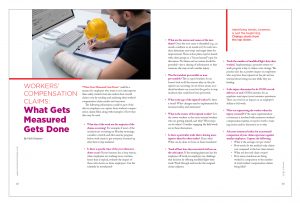Workers’ Compensation Claims: What Gets Measured Gets Done
“What Gets Measured Gets Done” could be a mantra for employers who want to not only improve their safety statistics but also reduce their overall claims costs by tracking and analyzing their workers’ compensation claim results and outcomes.
The following information could be part of the data an employer can capture from workers’ compensation claims filed, along with examples of how that data may be used.
- What day of the week are the majority of the claims occurring? For example, if most of the incidents are occurring on Monday mornings, consider a stretch-and-flex exercise program before work starts to get everyone loosened up after their 2-day weekend.
- Is there a specific time of the year when incidents occur? If your business has a busy season, when employees are working more overtime hours than is typical, evaluate the impact of those extra hours on those employees. Can the schedule be reevaluated?
- What are the nature and causes of the incidents? Once the root cause is identified (e.g., an unsafe condition or an unsafe act) for each incident, determine next steps and target dates for improvement. These action plans may be shared with other groups as a “lesson learned” topic for discussion. No blame and no names should be provided—just a sharing of information so that someone else may avoid a similar injury.
- Was the incident preventable or non-preventable? This is a good statistic for an
honest look at all the reasons why on-the-job injuries are occurring. As we all are aware, accidents/incidents can occur, but the goal is to stop incidents that could have been prevented. - What is the age of the injured worker? Is there a trend? What changes may be implemented for increased safety and awareness?
- What is the tenure of the injured worker? Is it the newer workers or the more tenured workers who are getting injured, and why? What steps can be taken? Consider engaging the field workers in these discussions.
- Is there a particular trade that is having more injuries than the other trades? If yes, why? What can be done to focus on fewer incidents?
- Track all lost time days associated with an on-the-job injury. If the treating physician has the employee off work, an employer can challenge that decision by offering modified/light-duty work. Work through and involve the assigned claims adjustor.
- Track the number of modified/light-duty days worked. Implementing a proactive return-to-work program is key to claims costs savings. The practice also has a positive impact on employees who may have been injured on the job and are worried about losing income while they are healing.
- Is the injury determined to be OSHA recordable (yes or no)? OSHA statistics for an employer may impact your insurance premiums. There can even be an impact on an employer’s ability to bid work.
- Who was supervising the worker when the injury occurred? If the same superintendent or foreman is involved with numerous workers’ compensation injuries, it may be worth a training session and/or discussion as to why.
- Ask your insurance broker for an actuarial comparison of your claim experience against similar employers. Capture the following:
• What is the average cost per claim?
• How much do the medical-only claims cost compared to the lost-time claims?
• What are the total claim counts?
• How many manhours are being worked in comparison to the number of total workers’ compensation claims being filed? - Capture incident/accident severity. This information can be broken out by category. For example:
• Category 1—minor first aid on site
• Category 2—clinic visit with minor treatment
• Category 3—clinic visit with physical therapy
• Category 4—hospitalization (may even include fatalities)
Since most states’ experience modification rates look at the prior 4 years of claims history, a 5‑year snapshot may be helpful in identifying trends. Many claims/risk management software packages allow the user (employer) to easily capture statistics such as those listed above. When an incident occurs, it is considered “green” or undeveloped. Then, as the claim progresses toward closure. it becomes developed. It is a good measurement to look at the snapshot of the data at the same point in time—such as when each claim was opened and at 6, 12, and 18 months—and see what the statistics show.
Identifying trends, however, is just the beginning. Change starts from the top down. Management support is critical as the entire organization gets energized and on board with goals for improvement. Commitment, flexibility, and adapting to making necessary changes are also key.
Disclaimer: This article is provided for educational purposes. We encourage you to consult with an expert for your unique considerations.

